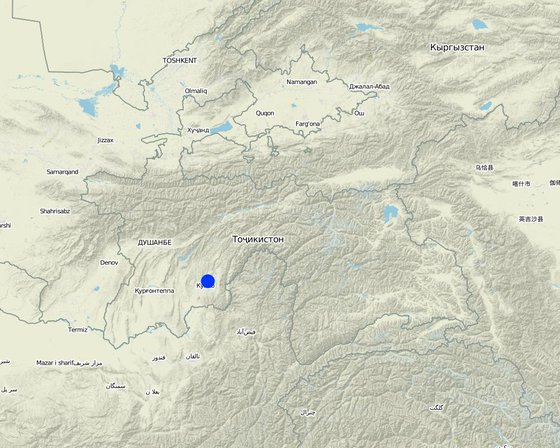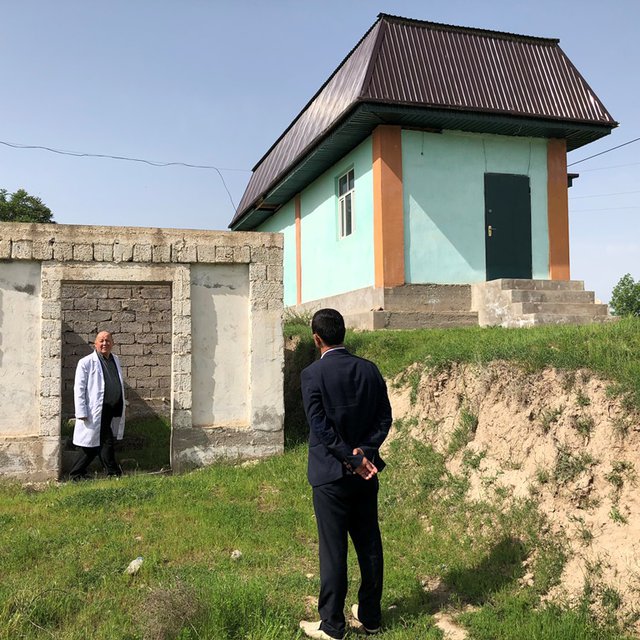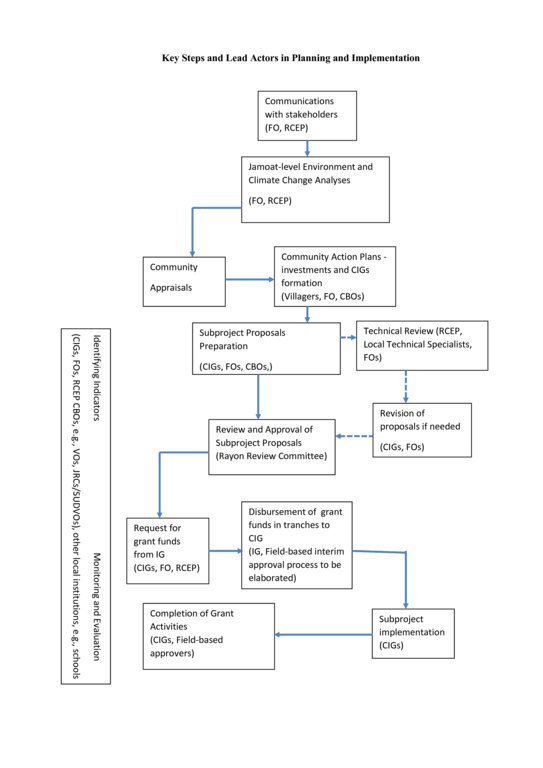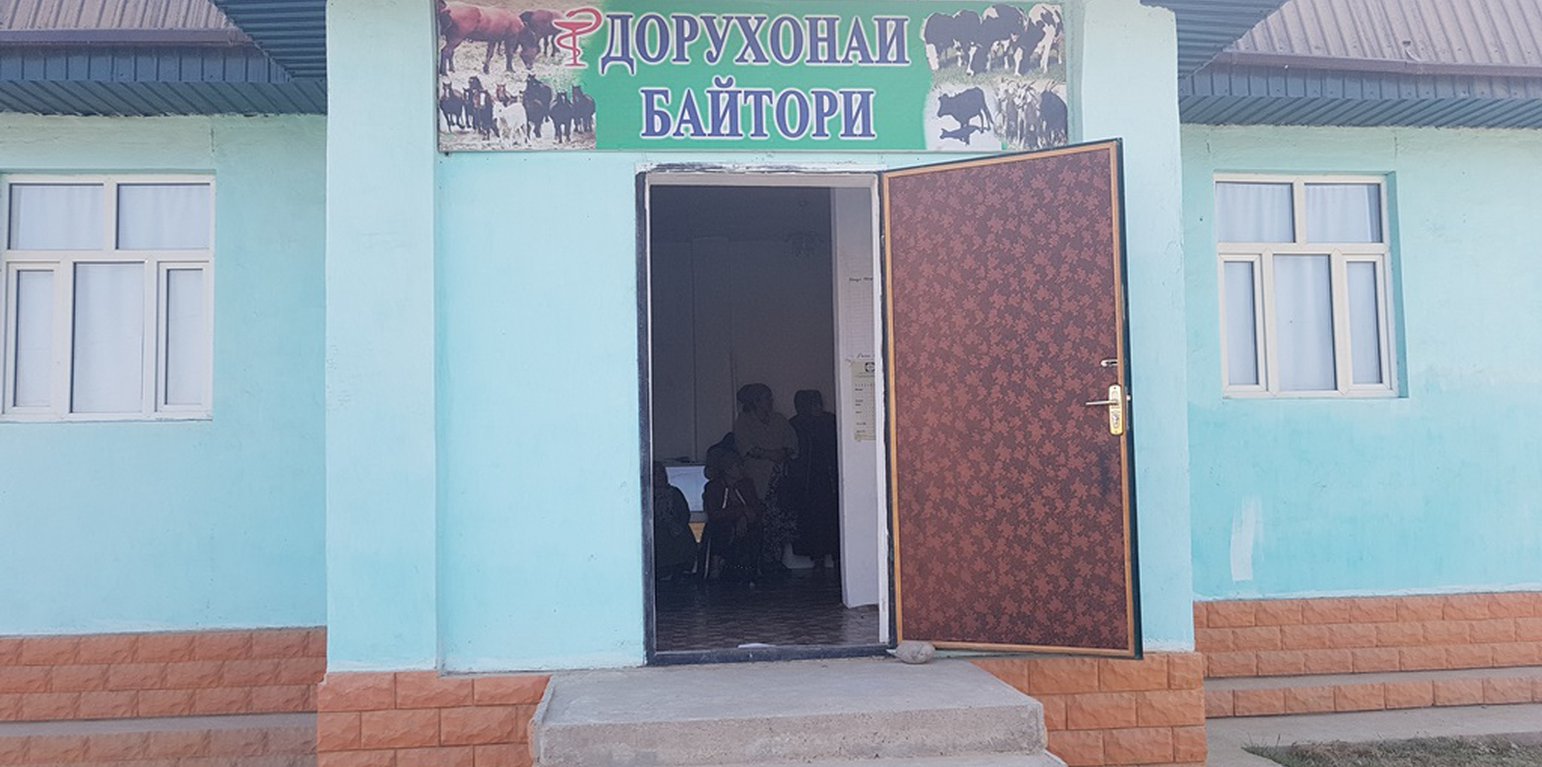Veterinary clinic contributing to the health level of the livestock and improved pastures through prevention activities
(ຕາຈິກິສະຕານ)
Дорухонаи байтори
ຄຳອະທິບາຍ
Improvement of the level of care and breeding cattle by opening a veterinary drugstore by this way to support livestock keepers somehow control pastures lands and livestock quantity
Animal diseases would not mention by livestock keepers as a problem. Likely because they themselves perceive the present losses as unavoidable. The veterinary staff, however, estimates the annual losses of livestock due to diseases at 5-10%. Reasons given for this is that vaccines are often not made available for entire herd populations, but are only sufficient for around 70% of the total number of animals. Furthermore are some vaccination only carried out in case of an outbreak of disease (ring vaccination) and not as a routine. It was also noted that the privatization of veterinary services is problematic as the taxation of services is making it difficult for the vets in the rural areas to make a living out of their service provision. According to data infections diseases, such as gangrene, foot and mouth disease, brucellosis and other infectious diseases were registered in this rural area so depending on the season monitoring is conducted. Except for infectious diseases, there are other parasites infections are met in this rural area. In the case of not carrying out vaccination in a timely manner they will be spread, as well as failure to timely prevent other diseases leads to the loss of livestock, which will also reduce the economic level of the population and their living. This was the first problem, the second and the main is the balancing of fodder and livestock, and only villagers need to discuss how either the production of fodder can be increased or the number of animals can be reduced in order to achieve the potential production level of the animals, for which balancing fodder and number of livestock is a precondition. There are several options for how the balance between fodder and animals can be restored. The villagers need to have a plan and it would stipulate controlled grazing measures, this group does not have a plan but they some of the prevention activities. As the result of the approach, they opened livestock registered book that they regularly monitored the number of the livestock, calendar with the type of disease season, breeding process, mortality of the livestock, artificial insemination of animals at the clinic is planned to open, and species of birds. Additionally, vet clinic group specialists have been trained a different type of the training on; pasture assessment practical, how to develop and implement a scheme for rotational grazing, how to monitor potential pasture yields, determining the quality of fodder and feeds, housing process and so on. On behalf of the project for the representatives all the groups been provided composting, mulching, managing salinization, intercropping on slopes, drip irrigation, low-cost watering techniques, solar greenhouses, drought-resistant crops, bee-keeping, mixed fruit orchards, local varieties nurseries, rotational grazing, livestock breeding and maintaining, strategic watering points, use of perennial forage, solar energy technologies, marketing options and opportunities trainings through the facilitation organisation
ສະຖານທີ່

ສະຖານທີ່: Ziraki Jamoat, Gulbogh Village, Kulob Region, Kulob District, ຕາຈິກິສະຕານ
ການຄັດເລືອກພື້ນທີ່ ທີ່ອີງໃສ່ຂໍ້ມູນທາງພູມີສາດ
ວັນທີເລີ່ມຕົ້ນ: 2015
ປີຂອງການສິ້ນສຸດ: 2017
ປະເພດຂອງແນວທາງ
-
ພື້ນເມືອງ / ທ້ອງຖີ່ນ
-
ການລິເລີ່ມ ພາຍໃນປະເທດ ທີ່ຜ່ານມາ / ນະວັດຕະກໍາ
-
ພາຍໃຕ້ໂຄງການ / ແຜນງານ

Vet drugstore and planned artificial insemination point (behind of the vet drugstore) (Kamolidin Abdulloev)
ເປົ້າໝາຍຂອງແນວທາງ ແລະ ການປົກປັກຮັກສາສິ່ງແວດລ້ອມ
ເປົ້າໝາຍ / ຈຸດປະສົງຫຼັກໃນການຈັດຕັ້ງປະຕິບັດແນວທາງ
The main goal of approach is to prevent infectious diseases of animals in a timely manner and infection of domestic animals, as well as to provide treatment and preventive measures for infectious diseases, such as immunization of cattle and small cattle and improving pasture lands through prevention activities
ເງື່ອນໄຂທີ່ສະໜັບສະໜູນໃຫ້ການຈັດຕັ້ງປະຕິບັດເຕັກໂນໂລຢີ ບົນພື້ນຖານແນວທາງ
ເງື່ອນໄຂທີ່ເຊື່ອງຊ້ອນໃຫ້ການຈັດຕັ້ງປະຕິບັດເຕັກໂນໂລຢີ ບົນພື້ນຖານແນວທາງ
-
ສັງຄົມ / ວັດທະນະທໍາ / ມາດຕະຖານ ແລະ ຄຸນຄ່າທາງສາສະໜາ: Besides, to purchase and increase good breeds of cattle adapted to the climate in this region. It is worth to note that the rural people were not aware of veterinary information. That resulted in that infectious diseases were spread because the population had eaten meat or sold in the market. Along with the implementation of this subproject these problems are disappearing.
-
ການກໍ່ຕັ້ງສະຖາບັນ: Non of institutions was functionedThe CIG head is Isroil Nazarov and an accountant is Hussein Abdurahmonov. They are responsible for the subproject activities implementation, make all their efforts and put their enthusiasm for the successful implementation. While carrying out preventive measures and treatment of farm animals rural people spend their service fees for the purchase of medicines and equipment. In the future, the head of the group is responsible to care of and make the veterinary clinic operation more sustainable.
-
ຄວາມຮູ້ກ່ຽວກັບການຄຸ້ມຄອງ ທີ່ດິນແບບຍືນຍົງ, ການເຂົ້າເຖິງການສະໜັບສະໜູນ ທາງດ້ານວິຊາການ: The livestock keepers and land users does not have sufficient knowledge to manage their lands On behalf of the project for the reprezentatives all the groups been provided composting, mulching, managing salinization, inter cropping on slopes, drip irrigation, low-cost watering techniques, solar greenhouses, drought resistant crops, bee-keeping, mixed fruit orchards, local varieties nurseries, rotational grazing, livestock breeding and maintaining, strategic watering points, use of perennial forage, solar energy technologies, marketing options and opportunities trainings through the facilitation organisation
ການມີສ່ວນຮ່ວມ ແລະ ບົດບາດຂອງພາກສ່ວນທີ່ກ່ຽວຂ້ອງທີ່ມີສ່ວນຮ່ວມ
ພາລະບົດບາດຂອງພາກສ່ວນທີ່ກ່ຽວຂ້ອງ ທີ່ມີສ່ວນຮ່ວມໃນການຈັດຕັ້ງປະຕິບັດແນວທາງ
| ແມ່ນໃຜ / ພາກສ່ວນໃດ ທີ່ເປັນເຈົ້າການ ໃນການຈັດຕັ້ງປະຕິບັດ ວິທີການ? |
ລະບຸ ພາກສ່ວນທີ່ກ່ຽວຂ້ອງ |
ພັນລະນາ ບົດບາດ ໜ້າທີ່ ຂອງພາກສ່ວນທີ່ກ່ຽວຂ້ອງ |
| ຜູ້ນໍາໃຊ້ດິນໃນທ້ອງຖິ່ນ / ຊຸມຊົນທ້ອງຖິ່ນ |
CIG Members |
The CIG head is Isroil Nazarov and an accountant is Hussein Abdurahmonov. They are responsible for the subproject activities implementation, make all their efforts and put their enthusiasm for the successful implementation. While carrying out preventive measures and treatment of farm animals rural people spend their service fees for the purchase of medicines and equipment. In the future, the head of the group is responsible to care of and make the veterinary clinic operation more sustainable. |
| ຜູ້ຊ່ຽວຊານ ການນຄຸ້ມຄອງ ທີ່ດິນແບບຍືນຍົງ / ທີ່ປຶກສາດ້ານກະສິກໍາ |
FOs and Academys |
Reprezentatives been involved during the TOT trainings |
| ອົງການຈັດຕັ້ງ ທີ່ບໍ່ຂື້ນກັບລັດຖະບານ |
FOs |
FOs provided their services to facilitate community mobilization, and preparation and implementation of sub-projects, as well as to strengthen the capacity of community based groups to undertake their respective project responsibilities |
| ອໍານາດ ການປົກຄອງທ້ອງຖິ່ນ |
Local hukumat and Jamoat |
Jamoat representatives was involved in Participatory Rural Appraisal (PRA) that was used as the main pre-assessment mechanism to analyze socio-economic and environmental situation in the selected pilots, The RRC(Rayon Reviw Committee) will consider the combination of proposed sub-projects within the overall context of the rayon and project. |
ການລວບລວມເອົາຜູ້ນໍາໃຊ້ທີ່ດິນໃນທ້ອງຖິ່ນ/ຊຸມຊົນທ້ອງຖິ່ນ ໃນການຈັດຕັ້ງປະຕິບັດແນວທາງ ແຕ່ລະໄລຍະ
ບໍ່ມີ
ການບໍ່ປະຕິບັດ
ການຊ່ວຍເຫຼືອຈາກພາຍນອກ
ການຮ່ວມມື
ການນໍາໃໍຊ້ເອງ
ການເລີ່ມຕົ້ນ / ແຮງຈູງໃຈ
There are 274 households residing in the village with the total number of 2225 people. The CIG head is Isroil Nazarov. He is as the specialist responsible for the subproject/approach activities implementation, make all their efforts and put their enthusiasm for the successful implementation
ການວາງແຜນ
The local land users prioritized investments based on a fixed budget for each type of rural investment determined by the number of households and on behalf of the CAP participants decided on the allocation of investments to groups of households (Common Interest Groups, CIGs) using rules that limit the funding for any one household. At least 50% of the village households should participate in either farm production or land resource management investments.
ການປະຕິບັດ
Villagers made grant allocation decisions. CIGs managed grant funds and purchased needed materials and products.
ຕິດຕາມກວດກາ / ການປະເມີນຜົນ
Local land users have activelly participated during the monitoring
ແຜ່ນວາດສະແດງ
Here is the key steps and actors in the planning and implementation of rural investments. Not all possible participants in these steps are included since local situations may vary and will need to be taken into account during planning and implementation.

ຜູ້ຂຽນ: ELMARL POM
ການຕັດສິນໃຈໃນການເລືອກເຕັກໂນໂລຢີ ການຄຸ້ມຄອງທີ່ດິນແບບຍືນຍົງ
ການຕັດສິນໃຈໂດຍ
-
ຜູ້ນໍາໃຊ້ດິນຜູ້ດຽວ (ການລິເລີ່ມດ້ວຍຕົນເອງ)
-
ຜູ້ນໍາໃຊ້ທີ່ດິນຫຼັກ, ການສະໜັບສະໜູນ ໂດຍຜູ້ຊ່ຽວຊານ ການນໍາໃຊ້ທີ່ດິນແບບຍືນຍົງ
-
ພາກສ່ວນກ່ຽວຂ້ອງທັງໝົດ, ເປັນສ່ວນໜຶ່ງ ຂອງວິທີທາງແບບມີສ່ວນຮ່ວມ
-
ຜູ້ຊ່ຽວຊານ ຫຼັກດ້ານການຄຸ້ມຄອງ ທີ່ດິນແບບຍືນຍົງ, ມີການຕິດຕາມປຶກສາຫາລືກັບຜູ້ນໍາໃຊ້ທີ່ດິນ
-
ຊຽ່ວຊານ ສະເພາະດ້ານການຄຸ້ມຄອງ ດິນແບບຍືນຍົງຜູ້ດຽວ
-
ນັກການເມືອງ / ຜູ້ນໍາ
ການຕັດສິນໃຈບົນພື້ນຖານ
-
ປະເມີນເອກກະສານ ຄວາມຮູ້ກ່ຽວກັບ ການຄຸ້ມຄອງ ທີ່ດິນແບບຍືນຍົງ (ຫຼັກຖານທີ່ຊ່ວຍໃນການຕັດສິນໃຈ)
-
ຜົນທີ່ໄດ້ຮັບ ຈາກການຄົ້ນຄວ້າ
-
ປະສົບການສ່ວນບຸກຄົນ ແລະ ຄວາມຄິດເຫັນ (ທີ່ບໍ່ເປັນເອກກະສານ)
-
Project initial phases
ການສະໜັບສະໜູນເຕັກໂນໂລຢີ, ການສ້າງຄວາມອາດສາມາດ ແລະ ການຄຸ້ມຄອງຄວາມຮູ້
ກິດຈະກຳ ດັ່ງລຸ່ມນີ້ ແມ່ນເປັນພາກໜຶ່ງຂອງແນວທາງ
-
ການສ້າງຄວາມສາມາດ / ການຝຶກອົບຮົມ
-
ການບໍລິການໃຫ້ຄໍາປຶກສາ
-
ສະຖາບັນການສ້າງຄວາມເຂັ້ມແຂງ (ການພັດທະນາອົງການຈັດຕັ້ງ)
-
ຕິດຕາມກວດກາ ແລະ ປະເມີນຜົນ
-
ການຄົ້ນຄວ້າ
ການສ້າງຄວາມອາດສາມາດ / ຝຶກອົບຮົມ
ໄດ້ສະໜັບສະໜູນຝຶກອົບຮົມໃຫ້ແກ່ພາກສ່ວນກ່ຽວຂ້ອງດັ່ງລຸ່ມນີ້
-
ຜູ້ນໍາໃຊ້ດິນ
-
ພະນັກງານພາກສະໜາມ / ທີ່ປຶກສາ
ຮູບແບບການຝຶກອົບຮົມ
-
ການເຮັດຕົວຈິງ
-
ຕົວຕໍ່ຕົວ
-
ເນື້ອທີ່ສວນທົດລອງ
-
ກອງປະຊຸມ
-
ຫຼັກສູດ
ກວມເອົາຫົວຂໍ້
Grant allocation mechanisms. Fund flow arrangements, management and technical
ການບໍລິການທາງດ້ານການໃຫ້ຄໍາປຶກສາ
ໄດ້ຮັບການບໍລິການທາງດ້ານການໃຫ້ຄໍາປຶກສາ
-
ໃນພື້ນທີ່ຂອງຜູ້ນໍາໃຊ້ດິນ
-
ສູນຄົ້ນຄວ້າ
Jamoat representatives and also local vet specialists from the district advise them
ຄວາມເຂັ້ມແຂງຂອງສະຖາບັນ
ສະຖາບັນ ໄດ້ຮັບການສ້າງຄວາມເຂັ້ມແຂງ
-
ບໍ່ມີ
-
ມີ, ໜ້ອຍໜຶ່ງ
-
ມີ, ພໍສົມຄວນ
-
ມີ, ຫຼາຍ
ໃນລະດັບດັ່ງລຸ່ມນີ້
-
ທ້ອງຖິ່ນ
-
ລະດັບພາກພື້ນ
-
ແຫ່ງຊາດ
ອະທິບາຍສະຖາບັນ, ພາລະບົດບາດແລະຄວາມຮັບຜິດຊອບ, ສະມາຊິກ, ແລະອື່ນໆ.
The Common Interest Groups formed in the villages on behalf households and enhanced their knowledge. And the project provides small-scale grants at the village level for groups of households (CIG) to implement rural production and land management investments, as well as related small-scale infrastructure investments. Villages will prioritize investments based on a fixed budget for each type of rural investment, determined by the number of households.
ຮູບແບບການສະໜັບສະໜູນ
-
ທາງດ້ານການເງິນ
-
ການສ້າງຄວາມອາດສາມາດ / ການຝຶກອົບຮົມ
-
ອຸປະກອນ
ລາຍລະອຽດເພີ່ມເຕີມ
Project-financed grants to CIGs for each investment under categories of rural production and land management investments, as well as related small-scale infrastructure investments that will not exceed US$7,000 and will require a match of 25% in beneficiary contributions which may be in cash or in-kind
ການສະໜັບສະໜູນທາງດ້ານການເງິນ ແລະ ອຸປະກອນຈາກພາຍນອກ
ງົບປະມານປະຈຳປີ ໃນກິດຈະກຳ ການຄຸ້ມຄອງທີ່ດິນແບບຍືນຍົງ ທີ່ເປັນສະກຸນເງິນໂດລາ
-
< 2,000
-
2,000-10,000
-
10,000-100,000
-
100,000-1,000,000
-
> 1,000,000
Precise annual budget: n.a.
GEF/PPCR through the WB
ການບໍລິການ ຫຼື ສິ່ງກະຕຸກຊຸກຍູ້ ດັ່ງລຸ່ມນີ້ ແມ່ນໄດ້ສະໜອງໂດຍຜູ້ນຳໃຊ້ທີ່ດິນເອງ
-
ການສະໜັບສະໜູນ ທາງດ້ານການເງິນ / ອຸປະກອນ ສະໜອງໃຫ້ແກ່ຜູ້ນໍາທີ່ດິນ
-
ຫຼຸດປັດໃຈນໍາເຂົ້າ
-
ສິນເຊື່ອ
-
ສິ່ງຈູງໃຈ ຫຼື ເຄື່ອງມືອື່ນໆ
ເງິນສະໜັບສະໜູນອຸປະກອນ / ສະໜອງໃຫ້ຜູ້ຊົມໃຊ້ທີ່ດິນ
The project will finance investments in three categories that are expected to improve household assets and sustainable land management, and build climate resilience, examples ofwhich are listed below: (i) Farm Production: field and horticultural crop productivity and diversity (e.g., crop rotations, drought resistant varieties, diversified cropping regimes, community seed funds, low-cost greenhouses), livestock production efficiency (e.g., breed choice, veterinary services), agro-processing and market access;(ii) Land Resource Management: pasture management (e.g., fodder productivity through appropriate species, rotational grazing, watering holes, growing perennials on slopes), watermanagement (e.g., drip irrigation and similar measures, water harvesting), soil fertility (e.g.,composting, mulch crops) integrated pest management (e.g., use of pheromone traps,biological controls) and sustainable sloping lands cultivation (including terracing, inter cropped orchards and woodlots, shelter-belts); and (iii) Small-scale Rural Production Infrastructure: irrigation/drainage system rehabilitation, minor transport infrastructure rehabilitation (e.g., repair of bridges), renewable energy (e.g.,low cost solar energy, and energy efficiency measures (e.g., improved stoves, insulation).Project-financed grants to CIGs for each investment under categories (i), (ii), and (iii) will not exceed US$7,000 and will require a match of 25% in beneficiary contributions which may be in cash or in-kind. Beneficiaries of rural infrastructure investments (category iii above) will have to contribute at least 5% of the total cost in cash at inception. Grants under this subcomponent will be disbursed in tranches directly to beneficiaries or groups to their own bank account with Amonatbank that has branches in most districts.
ການວິເຄາະຜົນກະທົບ ແລະ ສະຫຼຸບລວມ
ຜົນກະທົບຂອງການນໍາໃຊ້ແນວທາງ
ບໍ່
ມີ, ໜ້ອຍໜຶ່ງ
ມີ, ພໍສົມຄວນ
ມີ, ຫຼາຍ
ວິທີທາງ ຊ່ວຍຊຸກຍູ້ ຜູ້ນຳໃຊ້ທີ່ດິນທ້ອງຖີ່ນ, ໃນການປັບປຸງ ການມີສ່ວນຮ່ວມ ຂອງຜູ້ທີ່ກ່ຽວຂ້ອງ ບໍ່?
There are 274 households residing in the village with total number of 2225 people. The CIG head is Isroil Nazarov and an accountant is Hussein Abdurahmonov. They are responsible for the subproject activities implementation, make all their efforts and put their enthusiasm for the successful implementation. While carrying out preventive measures and treatment of farm animals rural people spend their service fees for the purchase of medicines and equipment. In the future, the head of the group is responsible to care of and make the veterinary clinic operation more sustainable
ການນໍາໃຊ້ ວິທີທາງ ສາມາດປັບປຸງຄວາມຮູ້ ແລະ ຄວາມສາມາດຂອງຜູ້ນໍາໃຊ້ທີ່ດິນ ໃນການປະຕິບັດ ການຄຸ້ມຄອງ ທີ່ດິນແບບຍືດຍົງໄດ້ບໍ່?
Trainings were organized and most of them had direct and indirect relation to SLM projects
ສິ່ງກະຕຸກຊຸກຍູ້ໃຫ້ຜູ້ນໍາໃຊ້ທີ່ດິນ ໃນການປະຕິບັດການຄຸ້ມຄອງທີ່ດິນແບບຍືນຍົງ
-
ການຜະລິດເພີ່ມຂຶ້ນ
-
ກໍາໄລເພີ່ມຂຶ້ນ (ຄວາມສາມາດ), ການປັບປຸງຄ່າໃຊ້ຈ່າຍ, ຜົນປະໂຫຍດ, ອັດຕາສ່ວນ
-
ຫຼຸດຜ່ອນດິນເຊື່ອມໂຊມ
-
ຫຼຸດຜ່ອນຄວາມສ່ຽງຂອງໄພພິບັດ
-
ການຫຼຸດຜ່ອນພາລະວຽກ
-
ການຊໍາລະເງິນ / ເງິນອຸດໜູນ
-
ກົດລະບຽບແລະລະບຽບການ (ລະອຽດ) / ການບັງຄັບໃຊ້
-
ກຽດສັກສີ, ຄວາມກົດດັນທາງສັງຄົມ / ການຕິດຕໍ່ກັນທາງສັງຄົມ
-
ລວມເຂົ້ານໍາກັນກັບການເຄື່ອນໄຫວ / ໂຄງການ / ກຸ່ມ / ເຄືອຂ່າຍ
-
ຄວາມຮັບຮູ້ ທາງສີ່ງແວດລ້ອມ
-
ພາສີ ແລະ ຄວາມເຊື່ອຖື, ສົມບັດສິນທໍາ
-
ການປັບປຸງ ຄວາມຮູ້ ແລະ ຄວາມສາມາດ ຂອງການຄຸ້ມຄອງ ທີ່ດິນແບບຍືນຍົງ
-
ການປັບປຸງຄວາມງົດງາມ
-
ການຫຼຸດຜ່ອນຂໍ້ຂັດແຍ່ງ
ຄວາມຍືນຍົງຂອງການຈັດຕັ້ງປະຕິບັດກິດຈະກໍາຂອງແນວທາງ
ຜູ້ນໍາໃຊ້ທີ່ດິນ ສາມາດຈັດຕັ້ງປະຕິບັດຕາມແນວທາງໄດ້ເອງບໍ່ (ໂດຍປາດສະຈາກການສະໜັບສະໜູນຈາກພາກສ່ວນພາຍນອກ)?
The CIG head is Isroil Nazarov and an accountant is Hussein Abdurahmonov. They are responsible for the subproject activities implementation, make all their efforts and put their enthusiasm for the successful implementation. While carrying out preventive measures and treatment of farm animals rural people spend their service fees for the purchase of medicines and equipment. In the future, the head of the group is responsible to care of and make the veterinary clinic operation more sustainable.
ບົດສະຫຼຸບ ແລະ ບົດຮຽນທີ່ໄດ້ຮັບ
ຄວາມເຂັ້ມແຂງ: ທັດສະນະມູມມອງ ຂອງຜູ້ນໍາໃຊ້ທີ່ດິນ
ຄວາມເຂັ້ມແຂງ: ທັດສະນະມຸມມອງ ຂອງຜູ້ປ້ອນຂໍ້ມູນເອງ
-
High-qualified specialists in the group
-
Office speace, where they will be able to conduct meetings with the farmers
-
Required knowledge
ຈຸດອ່ອນ / ຂໍ້ເສຍ / ຄວາມສ່ຽງ: ທັດສະນະມູມມອງ ຂອງຜູ້ນໍາໃຊ້ທີ່ດິນວິທີການແກ້ໄຂແນວໃດ
ຈຸດອ່ອນ / ຂໍ້ເສຍ / ຄວາມສ່ຽງ: ທັດສະນະມຸມມອງ ຂອງຜູ້ປ້ອນຂໍ້ມູນເອງວິທີການແກ້ໄຂແນວໃດ
-
Knowledge on the market analysis, fundraising, business planning
They need additional support on capacity building
-
Support on behalf of the district local government
They need to work more closely with the district and local government
-
New sources to go ahead
The group needs to come up with the requested letters to the sufficient donors or government funds
ເອກກະສານອ້າງອີງ
ວັນທີຂອງການປະຕິບັດ: July 7, 2018
ປັບປຸງລ່າສຸດ: July 17, 2018
ບຸກຄົນທີ່ສໍາຄັນ
-
Murod Ergashev (soil_m@rambler.ru) - ຜູ້ຊ່ຽວຊານ ດ້ານການຄຸ້ມຄອງ ທີ່ດິນແບບຍືນຍົງ
ການບັນຍາຍລາຍລະອຽດ ໃນຖານຂໍ້ມູນ ຂອງ WOCAT
ຂໍ້ມູນການເຊື່ອມໂຍງຂໍ້ມູນການຄຸ້ມຄອງການນໍາໃຊ້ດິນແບບຍືນຍົງ
ເອກກະສານ ແມ່ນໄດ້ອໍານວຍຄວາມສະດວກໂດຍ
ສະຖາບັນ
- Committee for Environment Protection of Tajikistan (Committee for Environment Protection of Tajikistan) - ຕາຈິກິສະຕານ
ໂຄງການ
- Environmental Land Management and Rural Livelihoods (ELMAR)
ການອ້າງອີງທີ່ສໍາຄັນ
-
ELMARL Annual Report 2017: Committee of Environment Protection of RT.
ເຊື່ອມໂຍງກັບ ຂໍ້ມູນຕ່າງໆ ທີ່ກ່ຽວຂ້ອງທີ່ມີ






